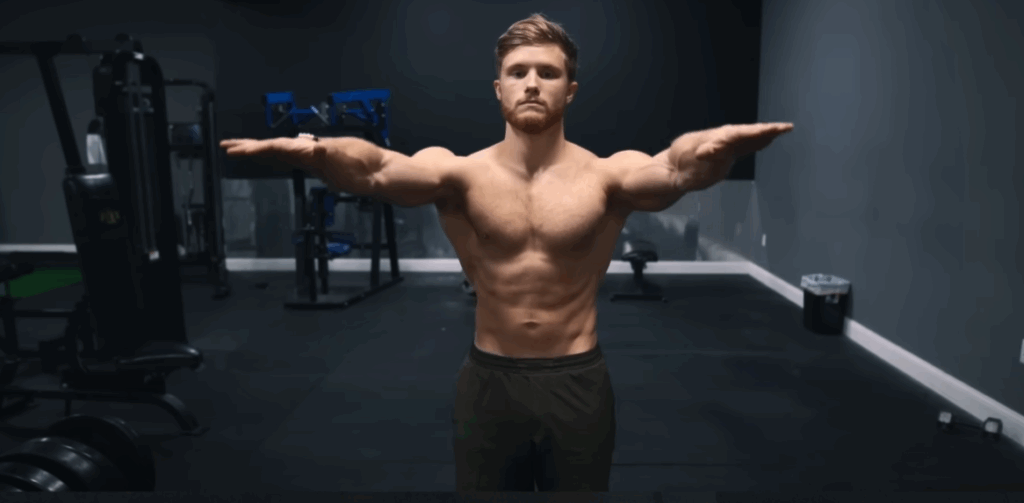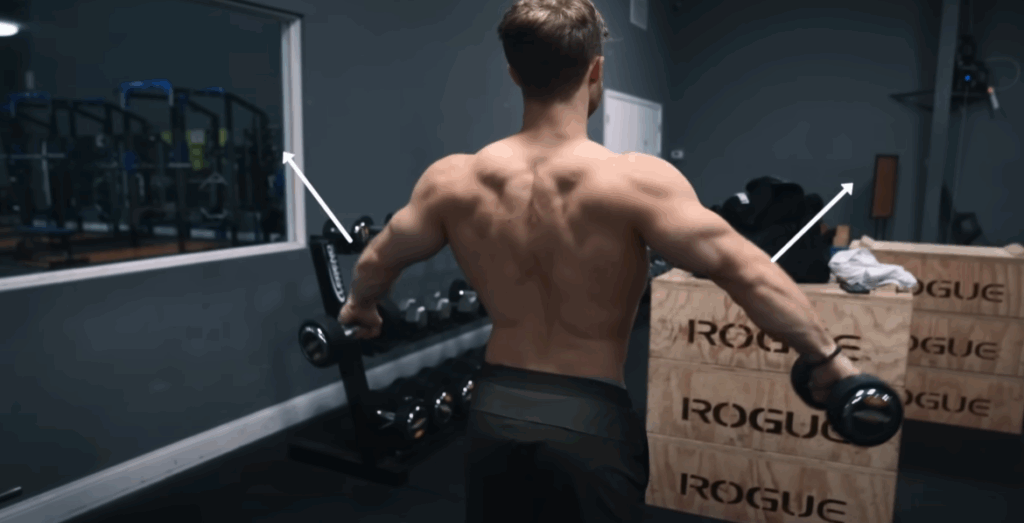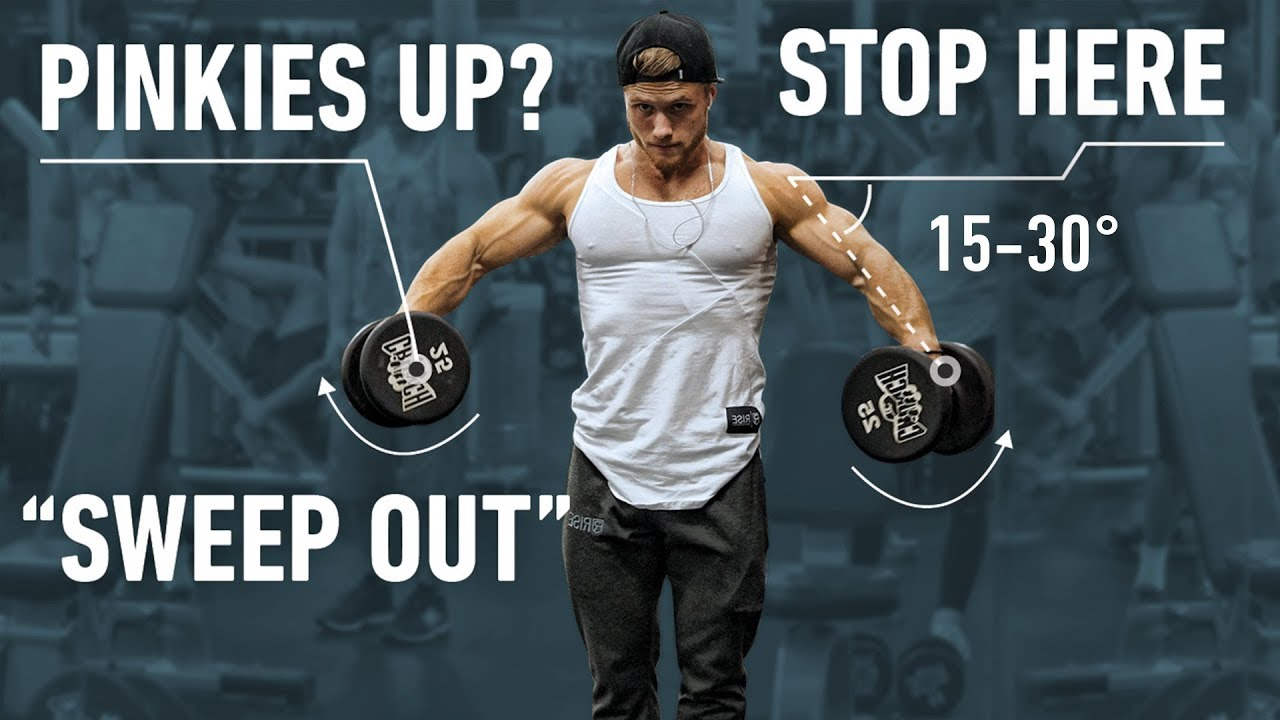If you want shoulders that stand out and create that iconic “V-taper” look, the lateral raise is an exercise you can’t afford to ignore. Well-developed side delts give your upper body width, enhance the illusion of a smaller waist, and complete an aesthetic physique.
But there’s a catch: most compound lifts, like bench presses and overhead presses, don’t adequately target the lateral deltoids. That’s why direct isolation work is essential if you’re serious about shoulder development. This guide breaks down how to perform the lateral raise correctly, optimize it for muscle growth, and avoid the most common mistakes.

Why the Lateral Raise Is Essential for Shoulder Development
The lateral raise primarily targets the lateral deltoid, the part of your shoulder responsible for abducting the arm (lifting it away from the body). While pressing movements hit the front delt and traps heavily, they barely stimulate the side delts.
Research has consistently shown that lateral raises—whether with dumbbells or cables—activate the lateral delts far more than pressing exercises. If you’ve been relying only on heavy presses to build round shoulders, you’re leaving serious growth potential on the table.
Strong side delts not only look impressive but also play a key role in shoulder stability and balanced upper-body strength.
Muscles Worked During the Lateral Raise
- Primary muscle: Lateral deltoid
- Secondary muscles: Front deltoid (slightly active if the arms move forward), upper traps (assist in scapular upward rotation)
- Stabilizers: Rotator cuff muscles, particularly the supraspinatus at the start of the lift
With proper technique, you can minimize trap involvement and keep the tension where you want it—on the side delts.
Dumbbell vs. Cable Lateral Raise – Which Is Better?
Both variations are effective, but they have different strengths:
- Dumbbell Lateral Raise: Simple, accessible, and effective. However, tension is highest at the top of the movement and minimal at the bottom due to gravity.
- Cable Lateral Raise: Keeps constant tension throughout the entire range of motion, making it great for a stronger pump and better mind-muscle connection.
A unique cable variation—sometimes called the “Egyptian lateral raise”—has you leaning away from the cable, which increases the range of motion and keeps tension on the side delt longer.
If you have access to cables, try both and see which one gives you the best contraction. But if you’re training at home or in a basic gym, dumbbells will still get the job done when performed correctly.

How to Perform the Perfect Dumbbell Lateral Raise
1. Starting Position
- Stand upright with a slight bend in the knees.
- Keep your core braced and glutes engaged to prevent swaying.
- Hold a dumbbell in each hand with a neutral grip (palms facing in).
For an even better side delt contraction, you can slide your index finger closer to the dumbbell head and your pinky closer to the middle of the handle. This creates a slight internal rotation, forcing the side delts to work harder.
2. The Movement
- Initiate with the elbows, not the hands. Think about driving your elbows outward and slightly upward.
- Raise in the scapular plane. Lift your arms about 15–30 degrees forward from your sides, not directly out or excessively in front of you.
- Slight internal rotation at the top. Leading slightly with your pinky (as if pouring water out of a jug) can increase side delt activation, but be cautious if you have shoulder impingement issues.
- Stop at shoulder height. Lifting higher shifts more tension to the traps rather than the delts.
- Lower slowly. Control the eccentric phase for 2–3 seconds, resisting the urge to let the dumbbells drop.
3. Breathing & Tempo
- Exhale as you lift the weight.
- Inhale as you lower it under control.
- For hypertrophy, a 2-second lift and 2–3-second lowering phase works best.
Optimal Sets, Reps, and Weight Selection
The lateral raise is an isolation movement with a long lever arm, meaning it doesn’t require heavy weights to be effective. In fact, going too heavy often shifts tension away from the delts and onto the traps.
- Reps: 10–20 per set (some advanced lifters go as high as 30 for a deep burn)
- Sets: 3–4 total
- Weight: Light enough to maintain perfect form. Even professional bodybuilders rarely use more than 20–30 lbs for strict sets.
Focus on progressive overload through better technique and stronger mind-muscle connection, not just heavier weights.
Common Mistakes to Avoid
- Using Momentum: Swinging the dumbbells or leaning back reduces delt activation. If you can’t lift the weight without jerking your body, go lighter.
- Shrugging the Traps: Keep your shoulders down and think about pushing the weight outward rather than upward.
- Turning It Into a Front Raise: Lifting the arms too far forward hits the front delts, not the side delts.
- Lifting Too High: Going above shoulder height shifts emphasis to the traps.
- Ego Lifting: Remember, this is a sculpting exercise, not a max-strength movement. If you can’t control the weight, you’re training the wrong muscles.
Advanced Techniques for More Growth
Once you’ve mastered strict form, you can experiment with intensity techniques:
- Constant Tension Reps: Don’t let the dumbbells rest at the bottom—reverse direction just before they touch your sides.
- Drop Sets: Start with your heaviest weight for strict reps, then immediately reduce the weight and continue without rest.
- Partial Reps at the End: After reaching failure, perform short, controlled lifts in the bottom half of the range to extend the set.
Are There Good Alternatives to the Lateral Raise?
While nothing fully replaces the lateral raise for isolating the side delts, there are variations and alternatives to keep your workouts fresh:
- Cable Lateral Raises (Standing or Leaning): Great for constant tension.
- Machine Lateral Raises: Provide guided motion and are easier on the joints.
- Upright Rows (Wide Grip): Can hit the lateral delts, but they also heavily involve the traps.
- Banded Lateral Raises: Perfect for home training or as a burnout finisher.

Final Thoughts
The lateral raise might look simple, but when performed correctly, it’s one of the most effective tools for building round, wide shoulders. Keep your form strict, use controlled movements, and prioritize tension on the side delts rather than chasing heavier weights.
Whether you choose dumbbells, cables, or machines, consistency and proper technique will give you the shoulder width and upper-body aesthetics you’re aiming for.



